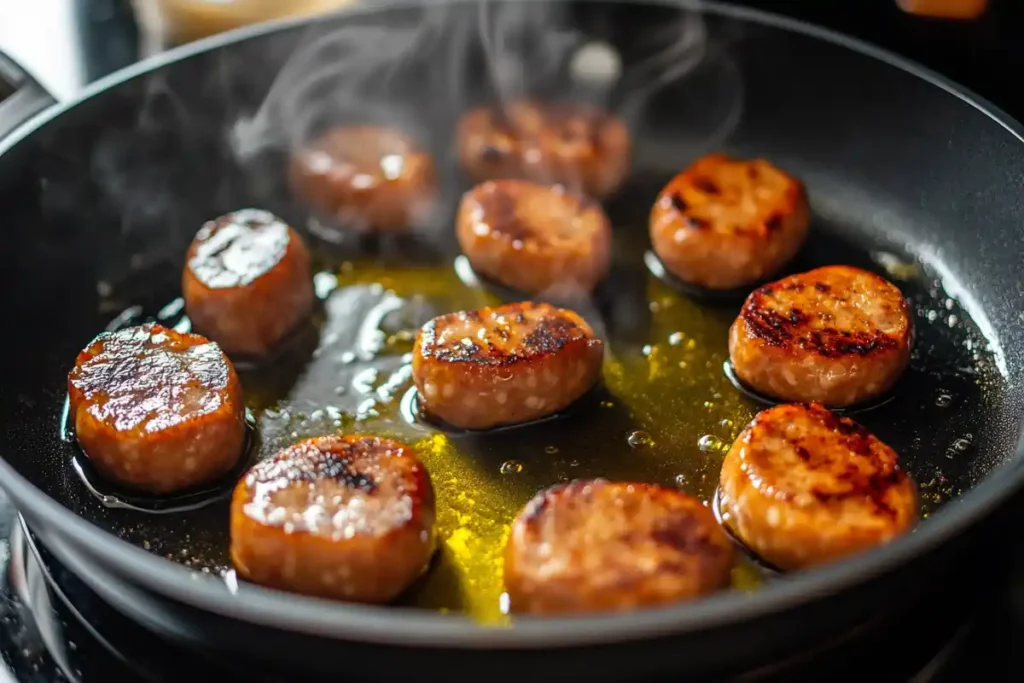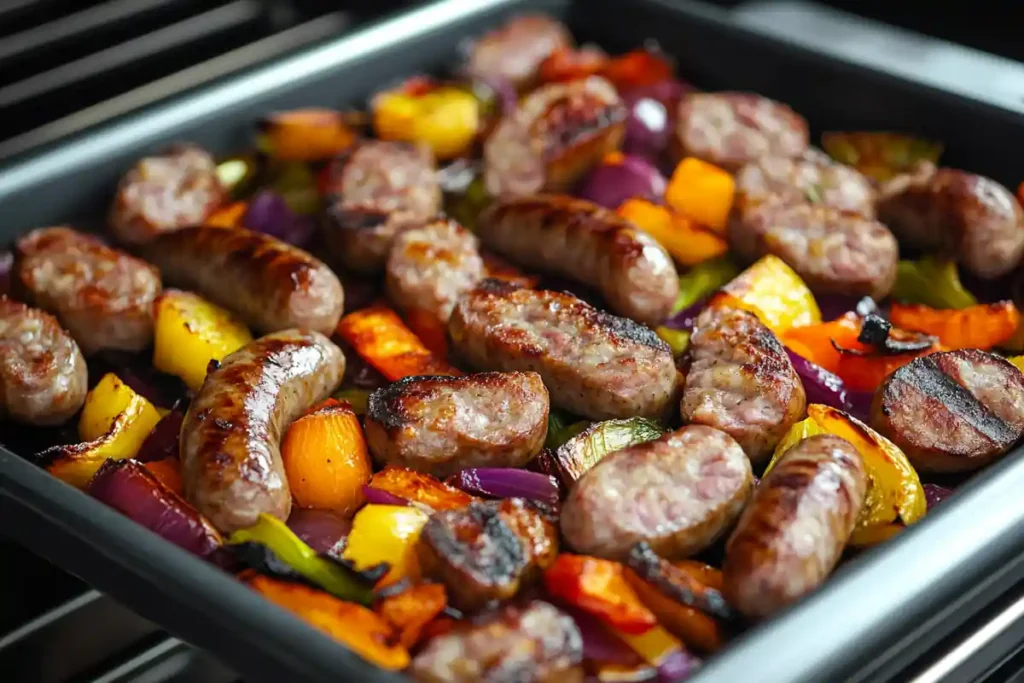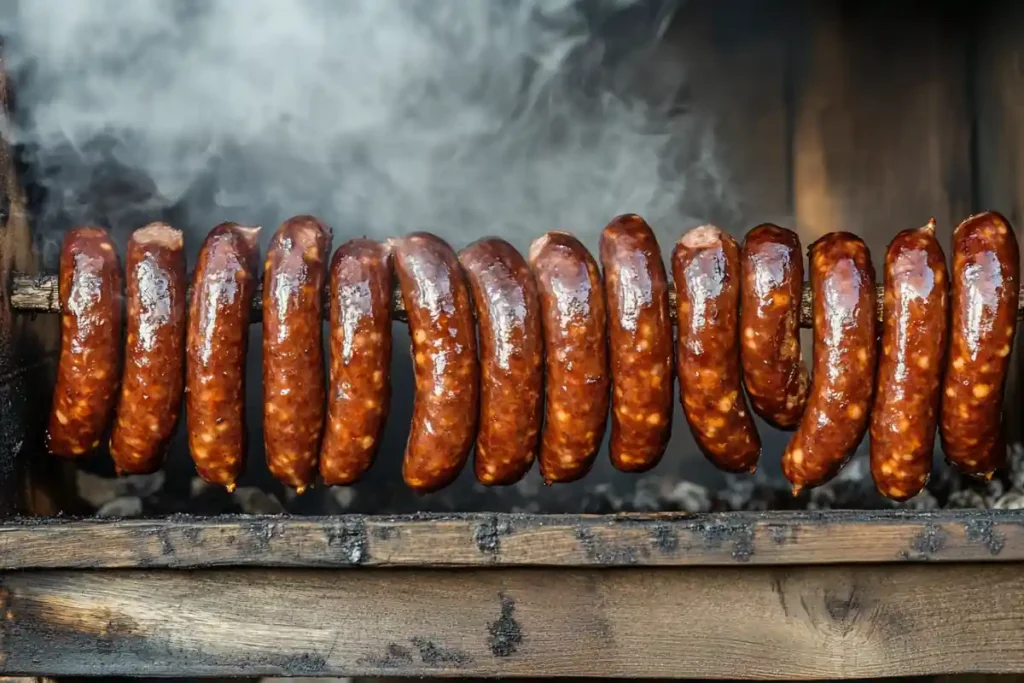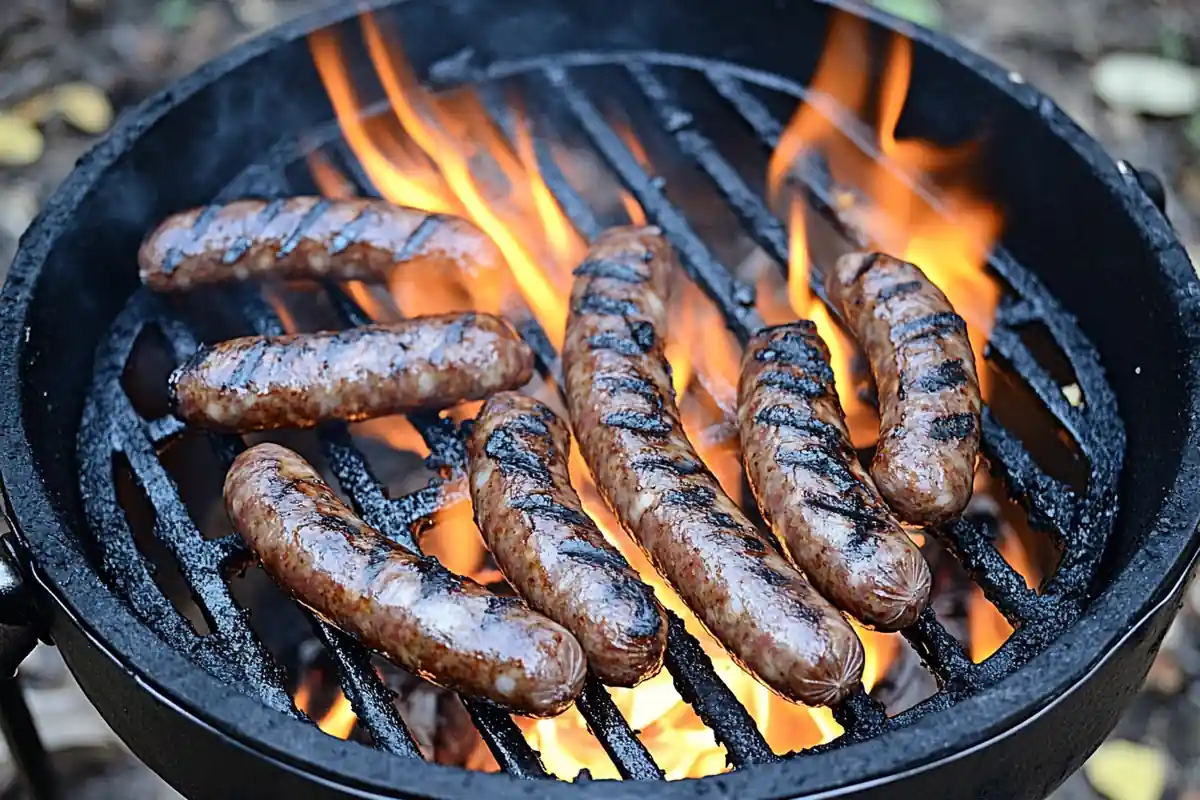Cooking venison sausages can feel like a culinary adventure, with their rich, gamey flavor and lean texture offering endless possibilities. But these delicacies demand care and precision to bring out their full potential. Whether you’re new to venison or a seasoned enthusiast, this guide will walk you through the preparation, cooking methods, serving ideas, and tips to make your sausages truly unforgettable. Let’s dive in and explore the best ways to cook venison sausages!
Table of Contents
Understanding Venison Sausages
What Are Venison Sausages?
Venison sausages are crafted from the lean meat of deer, often combined with a small amount of fat to enhance their texture and flavor. These sausages are renowned for their gamey and earthy taste, which distinguishes them from other varieties. Because deer meat is naturally low in fat, venison sausages are a healthy protein option for many. Unlike traditional sausages, they often feature simple, natural ingredients, allowing the flavor of the venison to shine.
Additionally, venison sausages are popular among hunters and food enthusiasts who value sustainable, organic meat. They can be seasoned with spices like sage, garlic, or fennel for a taste that’s both hearty and comforting.
Nutritional Benefits of Venison Sausages
One of the standout aspects of venison sausages is their impressive nutritional profile. Packed with lean protein, vitamins, and minerals, they’re an excellent choice for health-conscious eaters. Venison is a rich source of iron, which supports red blood cell production, and zinc, vital for immune function. Unlike fatty pork sausages, venison varieties have significantly lower levels of saturated fats, making them suitable for individuals following low-fat diets.
Furthermore, venison contains conjugated linoleic acid (CLA), which may support weight management and reduce inflammation. Paired with their distinctive taste, these sausages are as good for your health as they are for your palate!
Preparation Techniques
Preparing Venison Sausages for Cooking
Before you start cooking venison sausages, preparation is key. Because venison is naturally lean, proper handling and seasoning can significantly impact the final result. From thawing to marinating, this step ensures your sausages are flavorful, juicy, and ready to cook.
Thawing and Handling
If your venison sausages are frozen, it’s essential to thaw them correctly. Rapid thawing can affect the texture and increase the risk of bacteria. Instead:
- Place the sausages in the refrigerator overnight for a safe and even thaw.
- If you’re short on time, seal the sausages in a leak-proof bag and submerge them in cold water. Be sure to change the water every 30 minutes.
Once thawed, handle the sausages gently. Since venison is lean, rough handling can damage the casing or break the links. Always use clean utensils and wash your hands thoroughly to maintain hygiene.
Seasoning and Marinating Options
Seasoning venison sausages is a great way to enhance their naturally robust flavor. While the sausages often come pre-seasoned, a touch of extra spice or marinade can elevate their taste to new heights.
- Simple Seasoning: Sprinkle your sausages with cracked black pepper, sea salt, and a pinch of garlic powder before cooking.
- Herb-Based Marinade: Combine olive oil, fresh rosemary, thyme, and minced garlic to create a quick marinade. Let the sausages soak for 30 minutes for a subtle infusion of flavor.
- Spicy Kick: For a bold flavor, rub the sausages with cayenne, paprika, or red chili flakes.
Venison sausages also pair well with sweet flavors. Add a drizzle of honey or a splash of apple cider vinegar to balance their earthy taste.
Why Proper Preparation Matters
Skipping the preparation steps can lead to sausages that are tough, dry, or unevenly cooked. Marinating not only tenderizes the meat but also ensures that every bite bursts with flavor. Plus, thawing correctly preserves the sausage’s natural juices, keeping them moist during cooking.
Cooking Methods
Best Ways to Cook Venison Sausages
Cooking venison sausages is an art, and the method you choose can significantly influence their taste and texture. From quick pan-frying to slow smoking, each technique offers unique results. Below, we’ll explore the most effective ways to cook these delicious sausages while ensuring they stay moist and flavorful.
Pan-Frying Venison Sausages
Pan-frying is one of the simplest and quickest methods to cook venison sausages. It’s perfect for achieving a crispy exterior while retaining a juicy interior.

Steps for Pan-Frying:
- Heat a skillet over medium heat and add a drizzle of oil to prevent sticking.
- Place the sausages in the pan and cook them for about 8–10 minutes, turning frequently. This ensures even browning on all sides.
- Use a meat thermometer to check the internal temperature, which should reach 160°F (71°C).
Tip: Avoid overcrowding the pan, as this can prevent the sausages from cooking evenly. For added flavor, toss in some minced garlic or fresh herbs during the last few minutes of cooking.
Grilling Venison Sausages
Grilling is an excellent choice for venison sausages, imparting a smoky, charred flavor that complements their natural gaminess.
Steps for Grilling:
- Preheat your grill to medium heat. Lightly oil the grates to prevent sticking.
- Place the sausages on the grill and cook for 12–15 minutes, turning occasionally.
- Use tongs (not a fork) to handle the sausages, as piercing them can release precious juices.
For extra flavor, grill some onions or bell peppers alongside the sausages. Their sweetness pairs beautifully with the richness of venison.
Baking Venison Sausages in the Oven
If you prefer a hands-off method, baking venison sausages is ideal. It’s also a great option when cooking for a crowd.

Steps for Baking:
- Preheat your oven to 375°F (190°C).
- Arrange the sausages on a baking tray lined with parchment paper or foil.
- Bake for 20–25 minutes, flipping them halfway through. Check that the internal temperature reaches 160°F (71°C) before serving.
Pro Tip: Add a layer of vegetables, like potatoes or carrots, to the tray for a complete, easy-to-clean meal.
Slow Cooking Venison Sausages
Slow cooking is perfect for enhancing the flavors of venison sausages while making them incredibly tender.
Steps for Slow Cooking:
- Place the sausages in a slow cooker with your favorite sauce or broth. Popular choices include tomato-based sauces, onion gravy, or beef stock.
- Cook on low for 6–8 hours or high for 3–4 hours.
- Stir occasionally to ensure even cooking and flavor distribution.
This method is ideal for busy days or when you want a no-fuss meal. The sausages soak up the liquid, resulting in a dish that’s bursting with flavor.
Smoking Venison Sausages
For a truly unique and rich flavor, smoking venison sausages is hard to beat. It’s a slower process, but the results are well worth the effort.

Steps for Smoking:
- Preheat your smoker to 225°F (107°C) and add your preferred wood chips (hickory, apple, or mesquite work well).
- Arrange the sausages on the smoker racks, ensuring there’s enough space for airflow.
- Smoke for 1.5–2 hours or until the internal temperature reaches 160°F (71°C).
The smoky aroma and deep flavor make this method a favorite among food enthusiasts. Pair the sausages with a side of roasted vegetables for a hearty meal.
Cooking Tips and Safety
Ensuring Juicy and Flavorful Venison Sausages
Achieving tender and flavorful venison sausages doesn’t have to be tricky. By following a few simple tips, you can elevate your cooking game and avoid the common pitfalls that lead to dry or bland results.
Maintaining Moisture During Cooking
Venison is naturally lean, so retaining moisture is crucial. Here’s how to keep your sausages juicy:
- Add a Splash of Liquid: While cooking, introduce a small amount of water, broth, or sauce to the pan or grill. This prevents the sausages from drying out.
- Cook on Medium Heat: High heat can cause the casings to split and the meat to dry out. Opt for medium heat to ensure even cooking.
- Rest Before Serving: Once cooked, let the sausages rest for 2–3 minutes. This allows the juices to redistribute evenly throughout the meat.
Avoiding Common Cooking Mistakes
Overcooking and improper handling are the biggest culprits behind tough venison sausages. Here’s how to sidestep these issues:
- Don’t Pierce the Casings: Using a fork or knife to test doneness lets precious juices escape. Instead, rely on a meat thermometer.
- Turn Gently: Use tongs to turn the sausages, especially during grilling or pan-frying. Rough handling can cause the sausages to break.
- Watch the Cooking Time: Venison sausages cook quickly. Monitor the clock to avoid overcooking, which can make them tough and chewy.
Safe Internal Temperature Guidelines
Food safety is just as important as flavor when cooking venison sausages. The USDA recommends cooking ground game meats, including sausages, to an internal temperature of 160°F (71°C).
- How to Measure: Insert a meat thermometer into the thickest part of the sausage without touching the casing or pan.
- Safety First: Always use a clean thermometer to prevent cross-contamination.
Tip: For accurate readings, use a digital instant-read thermometer. This small investment ensures perfectly cooked venison every time.
Serving Suggestions
Pairing Venison Sausages with Sides and Beverages
Once your venison sausages are perfectly cooked, it’s time to pair them with sides that complement their rich, gamey flavor. Thoughtful pairings not only enhance the meal but also balance the boldness of venison.
Ideal Side Dishes
When selecting sides for venison sausages, aim for dishes that highlight their earthy taste while adding texture and variety to your plate. Here are some favorites:
- Roasted Vegetables: Root vegetables like carrots, parsnips, and sweet potatoes bring a touch of sweetness that complements the sausages.
- Mashed Potatoes: Creamy and hearty, mashed potatoes are a comforting classic that balances the leanness of venison.
- Grain Salads: A light quinoa or couscous salad with dried cranberries, walnuts, and fresh herbs adds a vibrant, tangy contrast.
- Stewed Greens: Wilted spinach, kale, or collard greens cooked with garlic and a splash of vinegar can cut through the richness of the sausages.
Recommended Beverages
While venison sausages are versatile enough to pair with a variety of drinks, here are some non-alcoholic options that work beautifully:
- Sparkling Water with Citrus: A refreshing option that cleanses the palate between bites.
- Apple Cider: The sweetness and acidity of cider enhance the sausages’ savory notes.
- Herbal Iced Tea: Flavors like mint or chamomile can provide a soothing accompaniment.
- Ginger Beer: Its zesty kick adds an exciting twist to the meal.
Elevating Your Presentation
For a visually appealing meal, consider arranging the sausages over a bed of greens or alongside a medley of roasted vegetables. Garnish with fresh herbs like parsley or thyme for a touch of elegance.
Tip: Serving sauces like grainy mustard, apple chutney, or onion marmalade on the side can provide additional layers of flavor.
FAQs About: Best Way to Cook venison
How Do I Prevent Venison Sausages from Drying Out?
Keeping venison sausages juicy is all about the right cooking techniques. Always cook on medium heat and avoid piercing the casing to retain moisture. Adding a splash of broth or water during cooking can also help. Finally, let the sausages rest for a few minutes before serving to lock in the juices.
Can I Cook Venison Sausages from Frozen?
Yes, but it’s best to thaw them first for even cooking. If you’re short on time, cook frozen sausages over low heat, adding extra cooking time to ensure they reach the safe internal temperature of 160°F (71°C). Be mindful, though, as cooking from frozen can result in unevenly cooked sausages.
What Internal Temperature Should Venison Sausages Reach?
To ensure both safety and optimal flavor, venison sausages should be cooked to an internal temperature of 160°F (71°C). Use an instant-read thermometer to check the temperature at the thickest part of the sausage without touching the pan or grill surface.
Are Venison Sausages Healthier Than Pork Sausages?
Absolutely! Venison sausages are naturally leaner than pork sausages, making them lower in saturated fat and calories. They’re also high in protein, iron, and zinc, providing essential nutrients for a balanced diet.
How Can I Add More Flavor to Venison Sausages?
Experiment with marinades, dry rubs, or sauces to enhance the flavor. A mix of garlic, rosemary, and olive oil works beautifully. You can also cook them with onions, peppers, or a touch of sweetness like honey or maple syrup to balance their earthy taste.
What Are Some Common Mistakes to Avoid When Cooking Venison Sausages?
- Overcooking: This can make the sausages tough and dry.
- Using High Heat: Medium heat is ideal for even cooking.
- Skipping Rest Time: Always let the sausages rest for a few minutes to retain their juices.
- Piercing the Casing: This releases the juices, leading to dryness.
Conclusion
Mastering the Art of Cooking Venison Sausages
Cooking venison sausages can be a delightful experience when approached with care and creativity. Their lean and gamey nature may seem challenging at first, but with the right techniques, these sausages transform into a succulent and flavorful dish that’s worth the effort.
Recap of Key Points
Throughout this guide, we’ve explored everything from preparation to serving suggestions:
- Start by properly thawing and handling venison sausages to preserve their quality.
- Choose a cooking method pan-frying, grilling, baking, slow-cooking, or smoking that suits your time and preferences.
- Keep the sausages moist by cooking on medium heat, avoiding casing piercings, and letting them rest after cooking.
- Pair them with complementary sides like roasted vegetables, mashed potatoes, or stewed greens to create a well-rounded meal.
- Use seasoning, marinades, or sauces to enhance their flavor and elevate your dish.
Encouragement to Experiment with Cooking Methods
Don’t be afraid to experiment! Venison sausages are incredibly versatile, allowing you to get creative with spices, sides, and cooking techniques. Whether you’re hosting a barbecue or preparing a cozy family dinner, there’s a perfect way to showcase these flavorful sausages.

